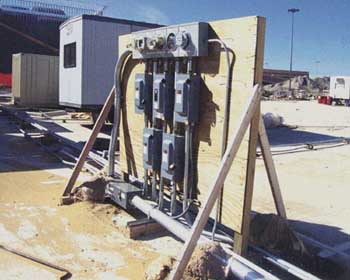The first thing one notices about Article 305, Temporary Wiring, in the 2002 National Electrical Code is that it is no longer there! By direction of the Technical Correlating Committee, Article 305 has been relocated to Chapter 5 and re-identified as Article 527.
Why move it and just add to all the confusion of finding things in a new code? A look at 90.3, indicates that Chapters 1-4 apply generally, and that Chapters 5-7 may modify the general rules of Chapters 1-4. What is a temporary installation if not a modification of the general rules, since temporary installations are by their nature temporary, and are held to a lesser standard of installation than permanent wiring. This is one of the basic premises of temporary installations. Requirements for permanent installation are not necessary unless specifically required because temporary installations are not intended to last forever, but to be removed when their short-term function is complete.

Photo 1. Outside temporary wiring service location
Section 527.2 reinforces the fact that all other requirements of the NEC apply unless 527 specifically modifies them. This means, for example, that insulated conductors must still be normally installed in a raceway or cable using their normal ampacities unless otherwise specifically permitted. Also, 527.2(B) allows the authority having jurisdiction (AHJ) to approve the methods based on their location and application. Hazardous locations would obviously have much more stringent requirements for temporary equipment and installation practices than holiday lighting out of reach of the general public.
Section 527.3 gives the guidelines for what would be considered “temporary.” Holiday lights and other similar seasonal events are limited to 90 days, while construction projects, emergency power, and power for testing purposes may go the entire length of the project or test. If there is any question whether any of these are temporary or not, the AHJ should be consulted before proceeding. At the end of the temporary period, all temporary wiring must be completely removed, not just disconnected.
The next part of Article 527 covers the general requirements for equipment used in temporary installations. Part A indicates that a service must conform with the requirements of Article 230, which means that a temporary service must be installed to the same standards as a permanent service would. This means an outdoor panelboard must be raintight, not an old residential service panel someone had laying around! Disconnecting means for circuits and feeders must be suitable for the use and location. Multiwire circuits must have a disconnecting means that opens all circuits simultaneously. If single-pole breakers are used on a multiwire circuit, approved handle ties (not 6 penny nails!) are allowed.

Photo 2. Receptacle outlet location within the structure
Feeders have to be in raceways, multiconductor cords, cable assemblies, or single conductor cords. The only exception to this is for tests and emergencies, where single insulated conductors may be used as long as they are accessible only to qualified personnel. This would mean that in case of an emergency, an installer would not have to try to find large ampacity multiconductor cables or cords, but could use the more available single conductors to get an electrical installation back in operation.
Branch circuits may use the same wiring methods as feeders, and both sections have an additional clarification that nonmetallic sheathed cable (NMC) cable may be used in buildings of all heights, not limited to three stories as Article 334 does in most permanent installations. Hard-usage cords may be laid on the floor where subject to foot traffic, but the other cables are required to be protected either by the building structure or by height. Cords must be protected from physical damage, such as where they pass through a doorway, as they are subject to pinching and other injury. Single conductors may be run for emergencies and tests as they are for feeders, but Part (D) additionally allows single conductors for holiday lighting as long as the voltage does not exceed 150 volts, the conductors are not subject to physical damage, and the conductors are properly supported on insulators. This allows the more commercial-type of holiday lighting installed on large buildings to use single conductors instead of cables or cords as long as they are out of reach of the general public. All wiring methods must be adequately supported by straps, cable ties, and so forth to prevent damage. This does not mean that the wiring method must have the same support intervals as required by its article for permanent installation, but have enough support so it will stay undamaged until removed at the end of the job. A change for the 2002 NEC now states that overhead temporary conductors shall not be supported from vegetation. Wiring methods may still be run up the trunk of a tree or other vegetation to supply power to equipment (such as lights) in that tree or bush, but overhead spans may no longer be supported. This relieves the AHJ from trying to make a determination whether a tree branch has adequate structural strength to carry the weight of the span, plus additional strain from wind and ice loads.
Section 527.4(D) requires that all receptacles be of the grounding type, and that all cable and cord circuit systems have the equipment grounding conductor attached directly to the grounding screw of the receptacle. Receptacles on construction sites may not be on the same circuit(s) as lighting, so if a receptacle circuit trips due to overload or fault it does not disable the lighting. Part (F) calls for all lamps for general illumination to have suitable protection from accidental breakage. Boxes must be provided for splicing temporary wiring, except on construction sites where a wiring method is used that provides equipment grounding continuity either with a conductor or cable sheath. These splices should still be placed where not subject to moisture or other factors which could prove detrimental to the conductors or cable. Also, any wiring method entering any type of enclosure must have a fitting approved for the purpose. This eliminates the old practice of running cords, cables, and so forth, through open knockouts in panelboards and boxes. With this old practice, the only strain relief for the cord or cable was the circuit breaker or wirenut on the conductor.
The portion of 527 dealing with the use of ground-fault circuit interrupter (GFCI) protection for personnel has been changed to severely limit the use of the assured equipment grounding conductor program (AEGCP) in place of GFCI protection. Construction, demolition, maintenance, and other similar projects must have GFCI protection for personnel on all 125-volt, single-phase, 15-, 20- and 30-ampere receptacles. The exception that allowed the AEGC program in certain industrial establishments has been limited only to equipment that could cause a greater hazard if tripped by a GFCI, or to equipment that, by its design, is not compatible with GFCI protection. A possible example is powered breathing apparatus for maintenance which could endanger a worker’s life if a GFCI tripped and left the worker without air. Also, there is certain testing equipment which, because of its design, will not hold on a GFCI. This does not mean that a defective piece of equipment which trips a GFCI is exempt—the defective equipment should be replaced.
The GFCI requirement is for all receptacles used for construction, both permanent and temporary. This protection may be obtained using a GFCI receptacle, breaker, or factory-assembled cordset incorporating GFCI protection. All other receptacles not included in the basic GFCI requirement may have either GFCI protection or use the AEGC program using the guidelines in 527.6(B)(2).
Finally, Article 527 may not be the only article you have to use to cover “temporary” events. Article 520 covers among other things, outdoor performance areas; Article 525 covers circuses, fairs and other similar events; Article 550 covers mobile homes and trailers used on construction sites and other outdoor locations. Any article in Chapters 5, 6 and 7 could also apply to a temporary installation, and should be consulted for any applicable requirements.
The relocation and re-identification of Article 305 to Chapter 5, Article 527, merely emphasize its role in modifying general wiring rules for temporary situations. As expressed earlier, time limitations and type of temporary installation are major considerations, as are the instructions to completely remove—not simply disconnect—all temporary wiring when the temporary situation no longer is required.








Find Us on Socials